-
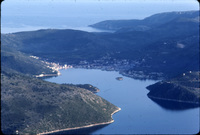
This image is a panoramic view of Vathy, the capital of Ithaca, as seen from a vantage point in the mountain range facing the city.
-
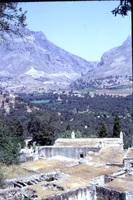
Pictured is the abandoned town of Eleutherna or Eleuthera in Crete, ancient Apollonia, and the presiding mountain range. Architectural ruins of Eleutherna are pictured. Some buildings have grass growing on top of them. Structures appear to be made out of stone.
-
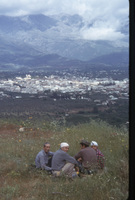
This is a picture of four Greek men sitting in the brush on a hill enjoying a meal. The hill rolls down into an agricultural plot of land, into the city, and then up into the Taygetos Mountain range.
-
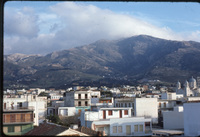
Karystos is a small costal town on the Greek island of Euboea. Pictured here is a view Mt. Ochi from a rooftop within the town. Clusters of bulidings and a church are used to contextualize the colossal size of Mount Oicha.
-

A man stands on top of a large rock with snow along a hill in the background. The label identifies the site as the Altar of Zeus, where offerings and sacrifices to the god would be made.
-
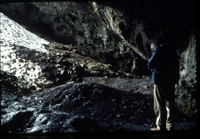
A man stands facing away from the camera in the foreground of the cave. The limestone appears pourous and is dark gray with white snow. The label identifies the man as possibly being "M. Fitch."
-
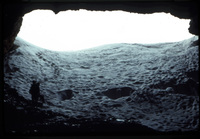
The image is pointed upward toward an opening in the Cave of Ida. The rocky, circular opening faces toward a light colored sky, and a person stands below. The photo is taken from inside of the cave.
-
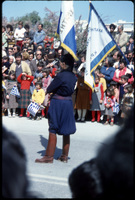
The image shows a man standing in the center holding a flag and dressed in traditional Greek clothing. Crowds of spectators stand in the background.
-
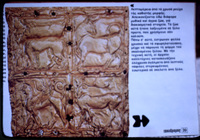
This image shows text accompanying a gold plaque from 6th century BCE Delphi divided into 4 sections with animal reliefs of a bull, gryphon, stag, and another unidentifiable animal. There are flower motifs in the borders between the sections.
-
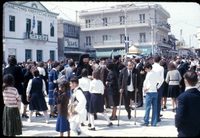
This image shows a street in the Greek town Mesolóngion with crowds of people, including adults and children. There are modern white buildings in the background. A man in a suit and on crutches, missing one leg, stands in the center, along with children in school clothes and Greek Orthodox priests in black attire.
-
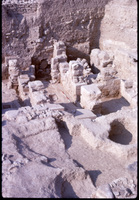
This image looks down at ruins of the archaeological site Kommos in South Crete. The angle of the image suggests that the site is set within the ground or further down a hill. There are several large stone walls that appear to delineate separate spaces, possibly rooms, with a circular carved stone set within one of the walls. A meter stick has been placed near the center of the image.
-
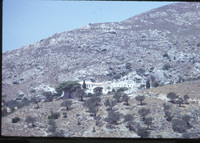
The image is facing upward toward a large white building or group of buildings situated on top of a rocky hill and at the foot of a larger mountain in the background.
-
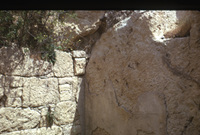
This image is a closeup of a rough, rocky wall made up of blocks of stone with some plants growing over the top on the left side. The left side of the wall is made up of clearly cut rectangular blocks of stone like that of ashlar masonry, whereas the right side is rough yet features patches of smooth stone and does not have the same indication of stacked construction. The Archaic wall is located in the village of Kastelliana, South Crete, Greece, which is above the seaside village Tsoutsouros.
-
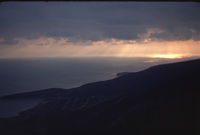
The sun, obscured by dark clouds, is setting over the ocean in the Euboea region of Greece. The photo is taken from a view over a hillside on the island of Skyra (or Skyros) in Euboea, and the hills show evidence of roads amongst the vegetation.
-
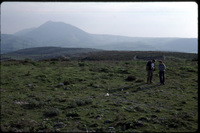
View of a rocky plain and some agricultural organization in the back along with a steep mountain in the far background of the image.
-
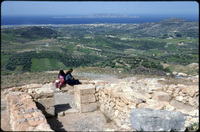
The photograph shows an archaeological site and the surrounding land. With the high altitude one can also distinguish the agricultural arrangements of the land, the coastline, and the ocean at a distance with a view of an island. Two women are seated to the left of center.
-
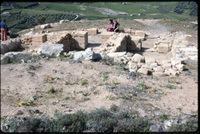
This photograph shows the archeological site of Anemospilia with its delimited spaces still precent by the wall foundations. The site consists of small compartments/rooms. Three people are pictured, two women and a man.
-
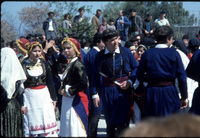
Mid-action photograph of women and men in traditional clothing. For women this includes a red head scarf, a white undershirt with a black long-sleeve jacket and a long white skirt. The men are wearing dark blue jackets with a red cloth band in their waist and dark blue pants made with the same material as their jacket.
-
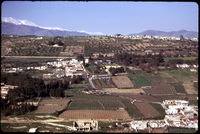
Aereal view of the Knossos with extensive capture of agricultural fields, with about three distinct clusters of domestic settlements, and mountain range in the background, including Mt. Ida.
-
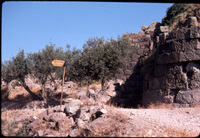
Stone construction made with thick stone blocks elevating above the tree line. There is a bulging construction in the foreground with an arrow with the inscription "place ou eta trouve... La Statue de Venus"
-
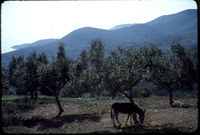
Photograph with view of a field of trees with a donkey on the foreground and mountains in the far background.
-
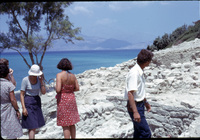
The picture shows 5 people (including Joseph Shaw on the right) in the foreground standing over what seems to be an archeological site with multiple levels getting narrower and deeper as it was excavated. The material seems to be symmetrical stone blocks. The background shows an ocean indicating the positioning of this site on the coastline looking out at mountains.
-
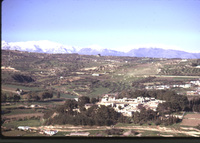
This is a landscape photograph of Knossos and Mt. Ida. The picture stretches far to show the palace in the foreground and the snowy mountain range in the background.
-
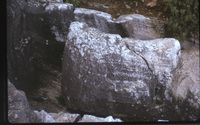
This is a frontal close up photograph of a large quarry on the Greek island of Naxos. Voids where stone has been removed are visible. The cuts are worn.
-
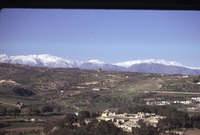
This is a view of a town and some ruins on flat land and a mountain range capped with snow in the background. The land is not densely packed with buildings, more like a few here and there.
























